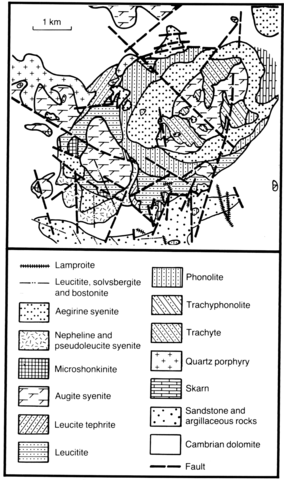stripes
The elliptical, 28 km2 Yakokut complex cuts through lower Cambrian dolomites and Jurassic terriginous deposits. The complex comprises both volcanic and plutonic rocks including dykes of alkaline and moderately alkaline comagmatic rocks. The volcanic rocks have been preserved as relicts within a deeply eroded caldera which has been heavily faulted. At the present level of erosion the volcanic rocks occupy the ground of lowest relief and have a maximum thickness of about 500 m. Three volcanic units have been distinguished. The lowermost horizon, some 200 m in thickness, is formed by lavas of feldspar epileucitite and leucitite. The middle unit, 200-250 m thick, is composed of lavas, lava breccias and tuffs of various leucitites and biotite leucite melaphonolites with thin intercalations of argillite and tuffaceous sandstone. The uppermost unit consists of lavas and lava breccias of leucite phonolite and trachyphonolite with rare layers of sandy limestone. The thickness of the upper unit is 150-200 m. In the middle volcanic unit, near the southern contact, numerous bodies, apparently sills, of black, porphyritic lamproites occur. Lamproites of a similar composition have also been found in the outer contact zone of the complex. Here they are represented by small dykes. Some isolated lamproite dykes have been located in the northern part of the complex (Bogatikov et al., 1986 and 1991). Within the Yakokut volcanics the moderately alkaline series, that is the trachytes, form the summits of bold peaks in the centre of the complex, but their age relationships with the strongly alkaline volcanics have not so far been established. The leucitites consist of microporphyritic pseudoleucite aggregates of orthoclase and albite (up to 30%) and 30% salite, in a groundmass consisting of microlites of orthoclase, albite and mica. Olivine-bearing leucitite consists of altered olivine (about 25%), which is replaced by mica, salite (30%) and microlites of orthoclase in the matrix. Phlogopite leucitite contains phenocrysts of phlogopite (20%) and diopside (10%) with orthoclase and albite in the groundmass. Biotite- leucite melaphonolite has phenocrysts of pseudoleucite and diopside (10%), while leucite phonolite has phenocrysts of orthoclase and mica and pseudoleucite aggregates. Three main series can be distinguished amongst the intrusive rocks of the complex. These are microshonkinites, which are the earliest intrusive series and apparently emplaced before extrusion of the volcanic units, arcuate bodies of nepheline and pseudoleucite syenite and peralkaline aegirine-augite syenites in the centre of the massif, which cut through the volcanic units. All these intrusive bodies are the upper parts of a large ring complex of alkaline rocks, which is not yet exposed. Moderately alkaline augite syenite forms a number of stocks which cut the peralkaline syenites. The intrusions of augite syenite are located both within and around the complex. Within the limits of the central complex and its contact zone a large number of approximately north-south-trending, 1-3 m thick dykes and several small, some 100 m diameter, subvolcanic stocks are known. They comprise olivine leucitite, leucitite, olivine-leucite-phlogopite phonolite, leucite-aegirine phonolite, bostonite, solvsbergite, syenite porphyry and lamproite.
BOGATIKOV, O.A., YEREMEYEV, N.V., MAKHOTKIN, I.L., KONONOVA, V.A., NOVGORODOVA, M.I. and LAPUTINA, I.P. 1986. Lamproites of the Aldan and central Asia. Transactions (Doklady) of the USSR Academy of Sciences, Earth Science Sections, 290: 154-7.
BOGATIKOV, O.A., RYABCHIKOV, I.D., KONONOVA, V.A. et al. 1991.
Lamproite. Nauka, Moscow. 320 pp.
KANUKOV, B.V., MAKHOTKIN, I.L. and GOLOVANOVA, T.I. 1991. Petrology of the potassic volcanic series of the Yakokut volcanic-plutonic complex of the Central Aldan. Izvestiya Akademii Nauk SSSR, Seriya Geologiya, 12:‚ 83-101.
MAKHOTKIN, I.l., ARAKEL'YANZ, M.M. and VLADYKIN N.V. 1989. On the age of the lamproites of the Aldan Province. Doklady Akademii Nauk SSSR, 306: 703-7.
MAKSIMOV, Ye.P. 1973. Mesozoic annular magmatic complexes in the Aldan Shield. International Geology Review, 15: 46-56.
MAKSIMOV, Ye.P. and UGR'UMOV, A.N. 1971. Mesosoic magmatic formations of the Aldan shield. Sovetskaya Geologiya. Moskva, 7: 107-19.

